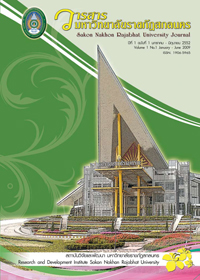การถ่ายทอดเทคโนโลยีเพื่อเพิ่มประสิทธิภาพการผลิตยางพารา จังหวัดสกลนคร
Abstract
บทคัดย่อ
การถ่ายทอดเทคโนโลยีการเพิ่มประสิทธิภาพการผลิตยางพาราจังหวัดสกลนคร เป็นชุดโครงการวิจัยประกอบ ด้วย 4 โครงการย่อย ได้แก่ การศึกษาสภาพการผลิตยางพาราในจังหวัดสกลนคร โดยวิธีการสัมภาษณ์เกษตรกรสวนยางพาราที่เปิดกรีดแล้วในอำเภอวาริชภูมิจำนวน 41 ราย การศึกษาตลาดยางพารา โดยวิธีการสัมภาษณ์ประธานกลุ่มเกษตรกรสวนยางพารา กรรมการกลุ่มเกษตรกรสวนยางพาราและพ่อค้าที่เข้าไปประมูลยางในตลาดประมูลยางของสำนักงานสงเคราะห์การทำสวนยาง (สกย.) และนักวิชาการของสำนักงานสงเคราะห์การทำสวนยางจังหวัดสกลนคร การศึกษาสภาพการปลูกยางพาราใหม่ โดยวิธีการสัมภาษณ์เกษตรกรในอำเภอพรรณานิคม จำนวน 40 ราย การศึกษาการเพิ่มผลผลิตยางพาราหลังเปิดกรีด ทำการทดลองแบบ Randomized Complete Block Design โดยการทดสอบปุ๋ยเคมี 3 สูตร ในแปลงเกษตรกร 1 ราย ในอำเภอวาริชภูมิ และการศึกษาชนิดพืชแซมยางในแปลงเกษตรกร จำนวน 2 ราย ในอำเภอพรรณานิคม ทำการวิจัยในระหว่างเดือนพฤษภาคม 2550 - กุมภาพันธุ์ 2551 และถ่ายทอดเทคโนโลยีการเพิ่มประสิทธิภาพการผลิตยางพารา โดยการฝึกอบรมในเรื่องการดูแลรักษาสวนยางพาราและการทำปุ๋ยหมัก ในอำเภอพรรณานิคม และอำเภอวาริชภูมิแห่งละ 1 วัน และวัดความพึงพอใจของผู้เข้ารับการอบรม ผลการศึกษาพบว่า
สภาพการผลิตและตลาดยางพาราของสวนยางที่เปิดกรีดแล้วในอำเภอวาริชภูมิ เกษตรกรมีพื้นที่ปลูกเฉลี่ย 24.21 ไร่ ใช้ระยะปลูก 2.5x7 เมตร พันธุ์ยางที่ปลูกคือพันธุ์ RRIM 600 มีการใช้ปุ๋ยเคมีสูตร 30-5-18 จำนวน 2 ครั้งต่อปี อัตรา 1-2 กิโลกรัมต่อต้น โดยการโรยเป็นแถบบริเวณระหว่างแถว 1 เมตร กำจัดวัชพืชโดยใช้เครื่องตัดหญ้าและใช้สารเคมีกำจัดวัชพืชพวกไกลโฟเสท โรคที่ระบาดในสวนยางคือโรคใบร่วง มีการป้องกันไฟไหม้ในสวนยางพารา โดยการไถพรวนรอบสวนเป็นแนว 3 เมตร มีระยะเวลาการกรีดยางเฉลี่ย 6.17 ปี มีระบบกรีดยางคือกรีดครึ่งต้น 2 วันเว้น 1 วัน เวลาในการเริ่มกรีดยางคือ หลังเที่ยงคืน จำนวนวันในการกรีด 20 วันต่อเดือน กรีดนาน 10 เดือนต่อปี ปริมาณน้ำยางที่กรีดได้มากกว่า 4,000 กิโลกรัมต่อปี ทำยางแผ่นโดยใช้กรดฟอร์มิก ในอัตรา 0.40 เปอร์เซ็นต์ มีการจำหน่ายยางพาราในรูปยางแผ่นดิบ และยางก้นถ้วย ในตลาดประมูลยางของสกย. ราคาจำหน่ายอยู่ระหว่าง 60-70 บาทต่อกิโลกรัม พ่อค้าที่ไปรับซื้อยางแผ่นดิบโดยผ่านตลาดประมูลเป็นพ่อค้าจากต่างอำเภอและต่างจังหวัด ซึ่งผลผลิตยางแผ่นดิบจะนำไปขายให้กับโรงงานผลิตยางที่จังหวัดระยอง อุดรธานี และหนองคาย
สภาพการปลูกยางพาราใหม่ อำเภอพรรณานิคม เกษตรกรมีพื้นที่ปลูกเฉลี่ย 16.75 ไร่ ใช้ระยะปลูก 3x7 เมตร พันธุ์ยางที่ปลูกคือพันธุ์ RRIM 600 มีการใช้ปุ๋ยเคมีสูตร 20-10-12 อัตราน้อยกว่า 200 กรัมต่อต้น และใช้ปุ๋ยอินทรีย์พวกปุ๋ยคอกในอัตราน้อยกว่า 2 กิโลกรัมต่อต้น มีการใส่ปุ๋ย 2 ครั้งต่อปี โดยใช้วิธีการหว่านรอบโคนต้น กำจัดวัชพืชโดยการไถพรวนลึก 15 เซนติเมตร ในระหว่างแถวยาง มีการตัดแต่งกิ่งแขนงในระดับต่ำกว่า 3 เมตร การป้องกันไฟในสวนยางพาราโดยการไถพรวนรอบสวนเป็นแนว 3 เมตร
การเพิ่มผลผลิตยางพาราหลังเปิดกรีดโดยการใช้ปุ๋ยเคมีสูตร 15-7-18 และปุ๋ยสูตร 30-5-18 ในอัตรา 500 กรัมต่อต้น ก่อนการกรีดยาง 1 เดือน ได้ปริมาณน้ำยาง 344.53 และ 321.73 กิโลกรัมต่อไร่ ในระยะเวลา 4 เดือน
การปลูกพืชแซมยางในระยะที่ต้นยางพารามีอายุไม่เกิน 3 ปี พืชที่ปลูกแซมยางได้แก่ มะเขือเทศ เกษตรกรมีรายได้สุทธิ 9,000-10,000 บาทต่อไร่ และข้าวโพดข้าวเหนียวมีรายได้สุทธิ 6,000-6,500 บาทต่อไร่
การถ่ายทอดเทคโนโลยีการเพิ่มประสิทธิภาพการผลิตยางพารา โดยการฝึกอบรมในเรื่องการดูแลรักษาสวนยางพาราและการทำปุ๋ยหมักแก่เกษตรกร ผลการวัดความพึงพอใจของเกษตรกรสวนยางพาราใหม่ อำเภอพรรณนานิคม มีความพึงพอใจอยู่ในระดับมาก เฉลี่ย 4.26 และความพึงพอใจของเกษตรกรสวนยางพาราหลังเปิดกรีด อำเภอวาริชภูมิ มีความพึงพอใจอยู่ในระดับมาก เฉลี่ย 4.26
Abstract
The objective of this research were to study the state of para rubber production and the para rubber market, to increase the production after the tapping has started and to study the intercrops in the new para rubber plantations in Changwat Sakon Nakhon. The state of production was studied by interviewing 41 para rubber farmers in Amphoe Waritchapoom who have started tapping their rubber trees. The para rubber market was studied by interviewing the chairpersons, committee members and the members of para rubber farmer groups, traders who bid in the bidding market of ORRAF (Office of Rubber Replanting Aid Fund) and specialists from ORRAF of Sakon Nakhon. The state of rubber production of new rubber farmers was studied by interviewing 40 rubber farmers in Amphoe Pannanikom. The method for increasing production after tapping has started was an RCBD experiment. Three formulars of inorganic fertilizer were experimented in one plantation in Amphoe Waritchapoome and kinds of inter-crops were studied in two plantations is Amphoe Pannanikom from May 2007 to August 2007. Technological transfer for higher efficiency of para rubbaer production by traning in knowledge of taking care of rubber plantation and making compost fertilizer, and to measure satisfaction with getting developed in knowledge among the farmers in Amphoe Pannanikom and Amphoe Waritchapoom.
The state of the para rubber production of the plantations after the tapping has started as follows : The average size of the plantation is 24.21 rai. The planting space is 2.5x7 meters. The clones used were RRIM 600. Half a kilo per tree of 30-5-18 chemical fertilizer was used twice a year by side dressing between rows one meter from the tree. Cutting machines and glyphosate were used for weeding. The disease often found was leaf blight. Fire prevention was made by harrowing a buffer zone 3 meters wide round the plantation. The rubber has been tapped for and average or 6.17 years. The tapping system was half spiral tapped two days within three days. The tapping begins after midnight. The tree in tapped 20 days per month, 10 months per year. The yield is over 4000 kilos per year per plantation. Formic acid is used at 0.40 percent in making rubber sheet. The rubber is sold the form of raw rubber sheets and latex coagulated in the cup. Through bidding to traders other amphoes or changwats. The traders will sell raw rubber to rubber factories in Udornthani, Nongkai or Rayong.
The state of the para rubber production of the plantation in Amphoe Pannanikom is as follows : The average size of the plantation is 16.75 rai. The planting space is 3x7 meters. The rubber clones used were RRIM 600. Less than 200 gramas per tree of formula 20-10-12 chemical fertilizer was organic fertilizer and farm manure less than two kilos per tree were used twice a year by sowing round the foot of the tree. Weeding in made by harrowing 15 centimeters deep between the rows. The pruning of branches below 3 meters is made . The cutting marks are allow to get dried. Fire prevention is made by harrowing a buffer zone 3 meters wide round the plantation. . The intercrop is corn. The problems related to rubber growing include scarcity of rubber clones, lack of fund for chemical fertilizer. The rubber farmers wanted the agencies concerned to give them technical advice in taking care of their plantation.
To increase para rubber production after the tapping has started 500 grams per tree of formulas 15-7-18 and 30-5-18 fertilizer was used one month before the opening of tapping. The yield will be 344.53 and 321.73 kilograms of latex per rai in four months.
For intercropping before the rubber trees are three years old tomato and local corn are grown. The earning from tomato production is 9,000-10,000 bath per rai per crop and the earning from corn is 6,000-6,500 baht per rai per crop.
Satisfaction with the given training in knowledge of taking care of rubber plantation and making compost fertilizer in Amphoe Pannanikom and Amphoe Waritchapoom were at the high level average 4.26 and 4.26.








